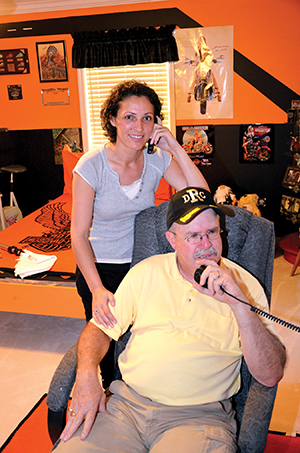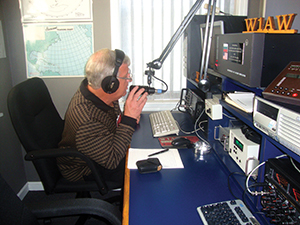Amateur radio spans the globe and helps out at home
By John N. Felsher

| View a short video clip here |
As the 20th century dawned, a new technology sparked onto the world, bringing people from diverse places in contact with each other across the chasms of culture and geography.
In December 1901, Guglielmo Marconi transmitted the first radio signal across the Atlantic Ocean, kicking off a boom in wireless communications that persists to this day. By 1909, the Wireless Association of America published a directory listing 89 amateur radio stations across the United States.
A century ago, in May 1914 to be precise, Hiram Percy Maxim founded the American Radio Relay League in Hartford, Connecticut, “to promote and advance the art, science and enjoyment of amateur radio.” Today, about 200,000 ARRL members continue that goal, part of more than two million amateur radio enthusiasts worldwide. About 2,000 “hams,” or amateur radio operators, practice their hobby in Alabama.
[column width=”1/3″] [box]
‘Alert, Alert, help me!’
When beginning a communication session, many ham operators say something like, “CQ, CQ, CQ, this is (their call sign) calling CQ,” which means the operator wants to talk to anyone who might respond.
“CQ” sounds similar to the English pronunciation of the French word “sécurité,” meaning “alert.” Anyone who watched the movie Titanic saw the captain instruct a wireless telegraph operator to send out a “CQD” message to inform others about the sinking ship. The “D” stands for “distress,” so the operator transmitted the message “Alert! Distress!”
The R.M.S. Titanic sank in April 1912. At about the same time, a new alert message started to gain popularity. In Morse code, SOS, for “save our ship,” is “dot, dot, dot; dash, dash, dash; dot, dot, dot,” a simpler code than the one for CQD. In fact, Jack Phillips, the radio operator on the Titanic, used both CQD and SOS codes when trying to bring help to his doomed vessel.
In 1923, radio operators began using the voice command “mayday” to indicate a life-threatening emergency, particularly with aircraft. The word “mayday” sounds similar to the French word “m’aider” in the phrase “venez m’aider,” meaning “come help me.” Mayday remains the international distress code to this day.
– John N. Felsher
[/box]
[/column]
“Ham radio is a hobby based around communications activities,” explains Ed Tyler, assistant director for the ARRL Southeastern Division in Pell City. “Most people get into it because of the fun and enjoyment they get out of it, the opportunity to meet other people and expand their own technical expertise and knowledge. Even today, there are still places where people can go and not get the internet or cell phone service, but they can get radio signals just about anywhere.”
The word “ham,” as a nickname for amateur radio operators, actually began as a pejorative term coined by late 19th century professional telegraphers who looked down upon the amateurs experimenting with wireless communications. In the 19th century, “ham” became a slang word for “bad” or “unskilled,” as in a ham actor. Over the years, though, amateur radio operators adopted the term with pride.
In the age of cell phones, texting, internet and other forms of instantaneous global communications, why would so many people continue to use a century-old technology? Although modern amateur radio operators rely upon the same type of signal that Marconi generated, as does a cell phone, modern ham operators use state-of-the-art digital processing systems to generate, transmit and decode that signal. These operators can communicate through a variety of voice, text, image and data communications with equipment that shares few traits with old vacuum tube radios.

Photo by
John Felsher
“Amateur radio is 100 years old,” says Clay Redden, an operator from Prattville. “The basic radio signal that was used a century ago remains the same, but now we get a lot more help from modern digital computers. I use several different types of computer devices and software to talk to people through the keyboard.”
For years, Redden worked as a professional radio news broadcaster and disk jockey in Montgomery. Commercial broadcasting can reach multitudes simultaneously, but only in a one-way communication — unless someone uses a telephone to call the station. In 1991, Redden became interested in engaging in two-way communications with others throughout the world.
“I’ve always been enamored by ham radio,” Redden recalls. “I started as a shortwave listener. For a long time, I listened to international broadcasters on the shortwave band, which is in the same general area as the ham frequencies. Once the FCC removed the requirement for learning Morse code, I took the test for a radio license.”
International treaties and the Federal Communications Commission designate a segment of the radio spectrum for use by licensed amateur radio stations. To obtain a federal license, prospective amateur radio buffs in the United States must pass a proficiency test that covers federal regulations, basic understanding of radio operations and other communications topics. In contrast, citizen band or CB radio operators do not need a license or any training, but can only use equipment with limited power and range.
With a license in hand, a radio enthusiast needs equipment. People can start communicating across the globe with basic equipment that only costs a few dollars or spend thousands for more sophisticated technology. To start, an operator needs a transceiver, power supply and an antenna. For an antenna, some hams simply string wire through tree branches.
“People can get into the ham radio hobby with brand new equipment for as little as $100,” Tyler advises. “Anywhere that I can carry a handheld radio, I can connect with another amateur radio operator. Many amateur radio operators like to swap equipment at “hamfests.” At hamfests, people can get equipment to operate a 100-watt station for a couple hundred dollars.
Depending upon atmospheric conditions, radio waves may bounce off the ionosphere, a layer of the upper atmosphere. These signals sometimes “ricochet” like a pool ball and hit diverse parts of the earth. The signal might hit California one day and New York the next day or even go completely around the world.
“Shortwave and ham radios use similar, but different frequencies,” Redden explains. “At night, the atmosphere becomes a lot more conducive to transmitting radio signals because radiation from the sun can affect some radio waves. Over the years, I’ve talked to people in Australia, New Zealand and Tahiti. I’ve also talked to the astronauts on the International Space Station. I’ve even talked to a Russian at his base near the South Pole. When talking to the Russian, several others joined in after they found out he lived in Antarctica.”
Many radio enthusiasts join local clubs all across the state. Experienced operators in clubs can help novices to get their licenses, buy the right equipment and provide technical advice. People can find a list of Alabama clubs at www.hamdepot.com/states/al.asp.

Photo courtesy of Alabama ARRL
“Amateur radio crosses the entire socioeconomic spectrum,” Redden says. “We’re always looking for more people to participate. Many clubs hold contests where operators see how many stations they can contact in a designated time period. Whoever contacts the most stations could win a trophy or a prize. Many ham operators help with the Cheaha Challenge, a charity bike ride up Cheaha Mountain. In that rugged area, cell phone service is spotty, so event organizers ask amateur radio clubs to help with communications so they can track the riders and provide help to emergency services personnel if needed.”
While ham operators never know who might hear their signals or respond, many amateur operators arrange specific times and frequencies to “meet” with their friends of the airwaves. Anyone capable of picking up that signal may listen to the conversation or join in, which makes ham operations so exciting for radio aficionados.
“Some people are really passionate abost going to remote places and seeing how many people they can contact,” Tyler noted.
Amateur radio can take on a much more serious purpose. A hurricane or tornado can knock down cell phone towers and severely hamper police and other emergency service communications. Many amateur operators own mobile radio equipment that they can take into affected areas and begin relaying messages for response teams.
When tornadoes devastated the Tuscaloosa area in April 2011, amateur radio operators responded in the first 24 hours to set up emergency communications and help first responders save lives.
“Amateur radio comes to the rescue many times,” Redden says. “In Alabama, we have a strong network of trained storm watchers. Once, I detected a funnel cloud and contacted the National Weather Service. They issued a tornado warning for the Wetumpka area that gave people about a 15- to 20-minute head start to take cover. When Hurricane Katrina hit the Gulf Coast in 2005, FEMA set up a staging area in Montgomery to send volunteers and supplies into the stricken areas. We set up a ham radio station to maintain contact with the New Orleans area. When all else fails, there’s amateur radio.”
Since the days of Marconi, radio signals bridged worlds. Whether for a brief recreational interlude or to save lives, those old signals still provide vital functions that bring people together through the comforting process of interpersonal communication. For information on ham radio operations, see www.arrl.org.




